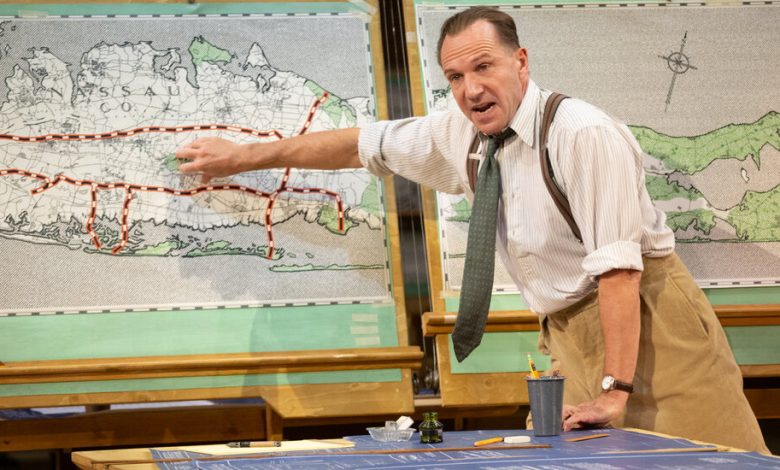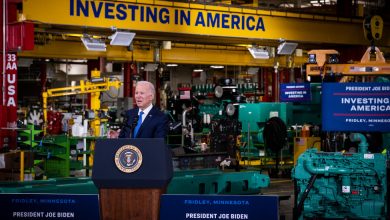Why Are We Still Obsessed With Robert Moses?

It is a wonder of some kind and a sign of the city’s renewed vibrancy that night after night, hundreds of people travel six flights by escalator to the main theater at the Shed on Manhattan’s far West Side to see Ralph Fiennes work himself into a state of near rapture over the promise of the Southern State Parkway. The actor is a few weeks into his performance as Robert Moses in “Straight Line Crazy,” David Hare’s confused effort at re-examining the influence of modern urbanism’s titanic autocrat. The play sold out quickly; ticket prices in the secondary market have since reached $900 a seat in some instances. Clearly, something is going on here.
But what is it precisely? Star power takes us partway toward an explanation but cannot drive us all the way home. “Straight Line Crazy” is two and a half hours long with much of the time given over to the didactic speeches of its protagonist and those who question his controversial reconfigurations of municipal geography. You would have to be something of an urban-planning nerd — or at least urban-planning-nerd-adjacent — to show up for all of this yelling in front of maps.
And yet should you fall into either of those categories, you won’t learn anything you don’t already know by way of “The Power Broker,” Robert Caro’s celebrated biography of Moses, the decades of commentary surrounding it, the frequency with which he comes up in contemporary debates about civic policy and the mountain of revived cultural interest in Jane Jacobs, his chief adversary. (Reviewing the play for Vulture, Jackson McHenry wrote that although he was not especially well versed in the history of New York, “I was left with a sense that I was getting ‘City Planning for Dummies’ all the same.”)
Jacobs, the author and patron saint of livable-streets activism, has been the subject over the past decade of two biographies and an acclaimed documentary. In 2016, her early magazine writing was compiled in the collection “Vital Little Plans.” Last month, an opera about her war with Moses over the fate of Lower Manhattan, “A Marvelous Order,” was staged at Penn State. Like Ruth Bader Ginsburg, her status as an icon has flourished in merchandise, her face showing up on tote bags, sometimes with the abbreviation WWJJD: “What would Jane Jacobs do?”
Jacobs would almost certainly not have bothered to see a play in which her ideas about the crucial role of neighborhoods in city life were presented so reductively. She remains a minor character in this telling, but strangely, so does Moses himself, whom we see here at two distinct points in his career. The first unfolds during the 1920s, when he is going up against the wealthy families of Gatsby country, on Long Island’s north shore, to build highways connecting New York City to the beaches and parks he is developing in Nassau and Suffolk Counties.
His wish to democratize leisure is bound to a fierce disdain for the rich but never translated into any concern for the poor. Moses’ loyalties lay more or less exclusively with the car-owning middle class, who he believed were just as entitled to the joys of the shoreline as the Whitneys and Vanderbilts around Oyster Bay. By the time Moses comes to us in the play’s second act, it is 1956, and his interests and ambitions have shifted to slum clearance and mowing down Greenwich Village to create an expressway.
How or why Moses became a supplicant to the religion of the automobile is not explored in the play, neither is anything else in his life that might have informed his ideologies — we’re told only that his wife is an alcoholic and that he went to Yale. But I suspect that some of the fascination with “Straight Line Crazy” stems from the politics it refracts to an urban bourgeoisie that is fed up at once with capital hoarding by the ultrawealthy and what it bemoans as a deterioration of civility — the rise in homelessness, the increasing crime, mounds of curbside garbage, more and more rats scurrying down tree-lined streets and so on. Really, who is standing up for the guy who pays $500 a month to park his RAV4 hybrid and then has to step over people sleeping on the street as he walks from his garage to the condo that he has outgrown but cannot afford to upgrade?
David Hare isn’t necessarily trying to force a total reappraisal of his subject, but he pries open a window wide enough for you to imagine that if Moses were around today, he would be railing against bail reform and vagrancy but also against private equity and Elon Musk.
Theater critics have noted the irony or aptness or simply the amusing matter of the play’s physical location, in Hudson Yards, a neighborhood — and I use that term loosely — manufactured out of imposition. Moses was at least a public-sector zealot. Whatever nostalgia there may be for his way of doing things comes in part from the fact that the power he wielded has since been given over to the real-estate class and the politicians all too happy to capitulate to it for the sake of campaign contributions. Moses, who never held elected office, didn’t need them.
The past 20 years provide too many examples of this sort of collusion to efficiently record, but as it happens, you can walk west on 30th Street toward the Shed, taking measure of the area surrounding Penn Station, which has been slated for an enormous development project that many find objectionable. The plan would result in the eviction of residential tenants and the demolition of old buildings largely to put in place roughly 18 million square feet of commercial space at a moment when remote work is ascendant and so many offices in Manhattan remain empty. There are currently three lawsuits aimed at stopping the project, but even if nothing ever gets built, the relevant property owners will watch the value of their land soar because they have already been granted development rights.
There’s a two-and-a-half-hour drama somewhere in this that would definitely be worth seeing.




